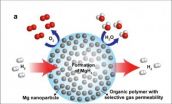(Press-News.org) PHILADELPHIA - For rodent pups, bonding with mom isn't hard-wired in the womb. It develops over the first few weeks of life, which is achieved by their maturing sense of smell, possibly allowing these mammals a survival advantage by learning to identify mother, siblings, and home.
Blending electrophysiological, biochemical, and behavioral experiments, Minghong Ma, PhD, an associate Professor of Neuroscience at the University of Pennsylvania School of Medicine, led a study published in a recent issue of the Journal of Neuroscience. With students Anderson Lee and Jiwei He, she demonstrated that neurons in the noses of mice mature after birth.
Using patch-clamping – a technique that measures electrical signals at the cellular level -- Ma's team found that between birth and day 30 of development, normal neurons become six times more sensitive to their sibling's scent, in this case, a fragrance called lyral. In addition, the mice transition from a relative indiscriminate response to different odors to being highly attuned to one specific smell. They also respond to that specific odor with a faster speed over time.
The olfactory marker protein (OMP) likely mediates this developmental maturation. In olfactory sensory neurons lacking OMPs, response fails to speed up over 30 days as compared to normal neurons. The authors suggest this could be due to altered intracellular communication, since loss of the protein is associated with decreased phosphorylation of an associated enzyme called adenylate cyclase, a key player in the chemical signaling underlying the sense of smell.
The team also used a novel behavioral assay to illustrate one consequence of mistakes in this cellular maturation process. Normal mouse pups, given the choice between their mother and an unrelated, lactating female, will choose to huddle with or suckle their mother 78 percent of the time. But in the absence of OMP, newborn mice fail to make that distinction.
According to Ma, the maturation of olfaction in early development could offer animals that need nursing and care for a long time before maturing (altricial species, including some mammals) a survival advantage. Rather than being hard-wired at birth, Ma says, they learn to identify their surroundings and their family. "They actually learn to find their mother, home, and siblings, and to stay alive," she says. But whether the same is true of human infants, of course, remains an open question.
One key question yet to be addressed, Ma says, is the mechanism underlying this olfactory tuning process. How, for instance, do the cells develop a faster response speed? How do they get so good at focusing on just one odorant to the exclusion of all others? And can this process be modulated by early experience? The answers to those questions, she says, could possibly provide tools to influence the bonding between mother and child in early development, and even promote social interactions in autistic children.
###
The article was funded by the National Institute on Deafness and Other Communication Disorders, National Institutes of Health.
Penn Medicine is one of the world's leading academic medical centers, dedicated to the related missions of medical education, biomedical research, and excellence in patient care. Penn Medicine consists of the University of Pennsylvania School of Medicine (founded in 1765 as the nation's first medical school) and the University of Pennsylvania Health System, which together form a $4 billion enterprise.
Penn's School of Medicine is currently ranked #2 in U.S. News & World Report's survey of research-oriented medical schools and among the top 10 schools for primary care. The School is consistently among the nation's top recipients of funding from the National Institutes of Health, with $507.6 million awarded in the 2010 fiscal year.
The University of Pennsylvania Health System's patient care facilities include: The Hospital of the University of Pennsylvania -- recognized as one of the nation's top 10 hospitals by U.S. News & World Report; Penn Presbyterian Medical Center; and Pennsylvania Hospital – the nation's first hospital, founded in 1751. Penn Medicine also includes additional patient care facilities and services throughout the Philadelphia region.
Penn Medicine is committed to improving lives and health through a variety of community-based programs and activities. In fiscal year 2010, Penn Medicine provided $788 million to benefit our community.
Mouse nose nerve cells mature after birth, allowing bonding, recognition with mother
2011-03-13
ELSE PRESS RELEASES FROM THIS DATE:
Miniature 'wearable' PET scanner ready for use
2011-03-13
UPTON, NY - Scientists from the U.S. Department of Energy's (DOE) Brookhaven National Laboratory, Stony Brook University, and collaborators have demonstrated the efficacy of a "wearable," portable PET scanner they've developed for rats. The device will give neuroscientists a new tool for simultaneously studying brain function and behavior in fully awake, moving animals.
The researchers describe the tool and validation studies in the April 2011 issue of Nature Methods.
"Positron emission tomography (PET) is a powerful tool for studying the molecular processes that occur ...
Stena Line Predicts 100% Increase in Indian Tourists to Mainland Europe
2011-03-13
Stena Line, one of the world's largest ferry operators, has announced it is predicting a 100 per cent increase in Indian passengers in 2011 on its twice daily ferry service between Harwich and the Hook of Holland.
Some 10,000 Indian tourists travelled the route between Harwich and the Hook of Holland in 2010 and 20,000 are expected to travel it in 2011 as Indians holidaying in Europe are trying to avoid the Air Passenger Duty (APD) costs that would be incurred if they chose to fly back home from the UK.
India is in the APD band C which means that the tax has doubled ...
Untapped crop data from Africa predicts corn peril if temperatures rise
2011-03-13
A hidden trove of historical crop yield data from Africa shows that corn – long believed to tolerate hot temperatures – is a likely victim of global warming.
Stanford agricultural scientist David Lobell and researchers at the International Maize and Wheat Improvement Center (CIMMYT) report in the inaugural issue of Nature Climate Change next week that a clear negative effect of warming on maize – or corn – production was evident in experimental crop trial data conducted in Africa by the organization and its partners from 1999 to 2007.
Led by Lobell, the researchers ...
Bupa Reveals the Average Brit is Cutting Life Expectancy by 12 Years
2011-03-13
Bupa has revealed that the average Brit is at risk of cutting more than a decade off their life through unhealthy lifestyle habits. This is according to new research from the leading international healthcare group.
The Bupa study assessed lifestyle behaviours such as smoking, alcohol intake, diet and exercise as well as other factors, in nearly 5,000 adults across Britain to calculate the nation's average Health Age, which is the impact that lifestyles are having on Briton's life expectancy.
The results showed that on average, Brits have a Health Age 12 years older ...
Consortium finds chronic liver cirrhosis clues
2011-03-13
Researchers have provided new clues into the genetics underlying a chronic form of liver disease, called primary biliary cirrhosis, which can lead to transplant surgery for patients. The new study identifies 15 genetic regions that affect a person's risk of developing the disease, more than trebling the number of known genetic regions, which now stands at 22.
The study was based on the genomes of 2,500 patients with primary biliary cirrhosis and more than 7,500 apparently healthy people. The results are the first to emerge from the Wellcome Trust Case Control Consortium ...
'Good cholesterol' structure identified, could help explain protective effects
2011-03-13
CINCINNATI—University of Cincinnati (UC) researchers have determined the structure of human HDL cholesterol and say the finding could help explain how this "fat packet" protects against cardiovascular diseases, including heart attack and stroke.
The study, led by W. Sean Davidson, PhD, professor in UC's pathology and laboratory medicine department, appears online ahead of print March 13, 2011, in the journal Nature Structural & Molecular Biology.
HDL (high-density lipoproteins) also known as "good cholesterol," are packets of protein and fat that deliver fat to specific ...
Combination overcomes breast cancer resistance to herceptin
2011-03-13
HOUSTON - Breast cancer tumors take numerous paths to resist the targeted drug Herceptin, but a single roadblock at a crucial crossroads may restore a tumor's vulnerability to treatment, scientists at The University of Texas MD Anderson Cancer Center report on line at Nature Medicine.
Adding the drug saracatinib to Herceptin treatment shrinks previously resistant tumors by cutting off at least five different molecular pathways, each of which can resist, said senior author Dihua Yu, M.D., Ph.D., professor in MD Anderson's Department of Molecular and Cellular Oncology.
"Scientists ...
Bigmouthmedia Expands Analytics Services with Nedstat Professional Accreditation
2011-03-13
Bigmouthmedia has expanded the range of analytics services on offer to clients after announcing that the agency has been awarded global professional accreditation status by Nedstat.
Underlining bigmouthmedia's expertise in web analytics, two members of its team recently passed Nedstat's prestigious Sitestat professional exam qualifications. The accreditation, which will allow the agency to work as a Sitestat Authorized Partner, represents the latest step in the company's strategy to expand and diversify the range of services on offer to clients.
"This is a significant ...
With new method, CSHL team is able to infer how tumors evolve and spread
2011-03-13
Cold Spring Harbor, NY -- A new method of analyzing cancerous tumors developed by scientists at Cold Spring Harbor Laboratory (CSHL) suggests that tumors may not evolve gradually, but rather in punctuated or staccato-like bursts. It is a finding that has already shed new light on the process of tumor growth and metastasis, and may help in the development of new methods to clinically evaluate tumors.
The new analytic method, devised by CSHL Professor Michael Wigler and colleagues, features a process called single cell sequencing (SNS), which enables accurate quantification ...
Berkeley Lab scientists achieve breakthrough in nanocomposite for high-capacity hydrogen storage
2011-03-13
Since the 1970s, hydrogen has been touted as a promising alternative to fossil fuels due to its clean combustion —unlike hydrocarbon-based fuels, which spew greenhouse gases and harmful pollutants, hydrogen's only combustion by-product is water. Compared to gasoline, hydrogen is lightweight, can provide a higher energy density and is readily available. But there's a reason we're not already living in a hydrogen economy: to replace gasoline as a fuel, hydrogen must be safely and densely stored, yet easily accessed. Limited by materials unable to leap these conflicting ...



